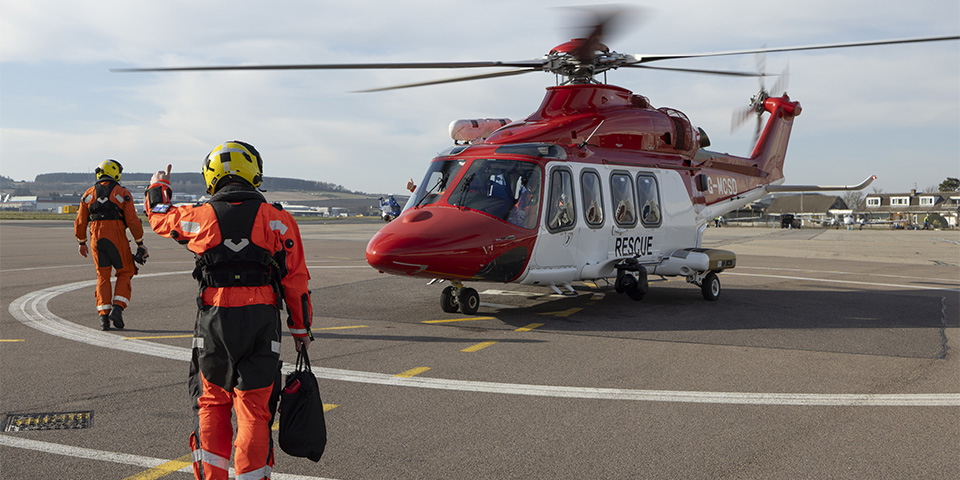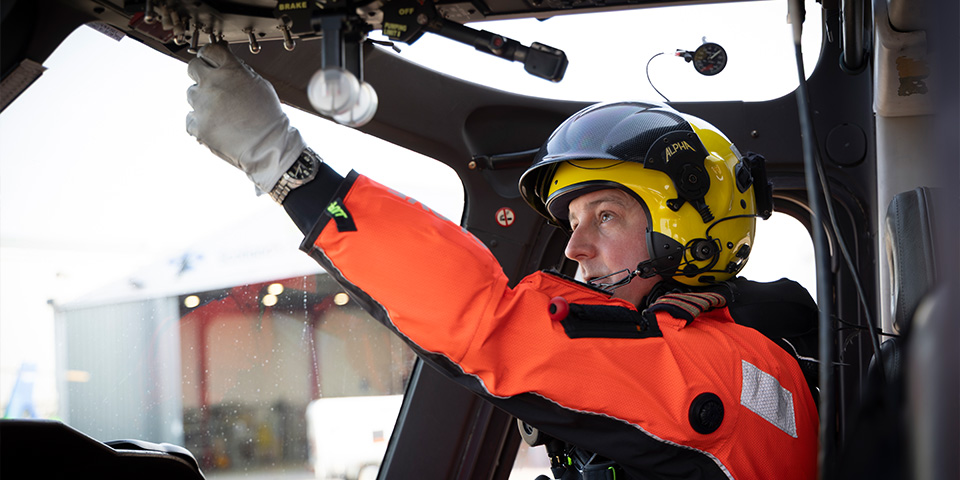During the time we spend with the OHS SAR team, the weather in Aberdeen is wall-to-wall sunshine. We are reminded that this is not normal, but then again very little about the work of the SAR crews could be described as normal or routine. They do a remarkable job.
For the past decade OHS has delivered what is known as the Industry SAR service. The service is a vital ‘safety net’ for a 10,000-strong community of oil and gas personnel who call the North Sea home for large parts of the year.
The Industry SAR contract is supported and funded by 19 partners in the offshore energy sector. It ensures there is a round-the-clock emergency medical service on call to respond to a wide variety of medical or SAR incidents. The service is separate from the UK Maritime and Coastguard Agency (MCA) that coordinates maritime SAR response nationally.
“Around 85% of the taskings we receive are medical intervention missions – where our crews take emergency medical care directly to an offshore installation", explains Keith Chalmers, SAR Manager. “That could be someone experiencing cardiac problems, for example. Or there may have been an accident that requires urgent medical intervention. Then we also have a proportion of our callouts that are specifically search and rescue.
"If you think about that community working offshore, it’s like a small village. People work there, but it’s also their home for a time.
"There are medical facilities on board the rig. But sometimes there’s a need to get a patient back to shore and to hospital urgently. That’s the security blanket we provide. And it’s why our crews are ready to respond 24/7.”

How OHS operates
The OHS facility is located at Aberdeen International Airport, from where the company manages two main activities. It operates a mixed helicopter fleet that provides a regular timetable of crew change flights. These flights ferry offshore workers and logistics to and from installations in the North Sea.
There is a well-equipped terminal where passengers pass through security before entering lounges to await boarding. The facility also houses a canteen, as well as rooms set aside for pre-flight briefings. Once briefed, offshore workers change into their allocated survival suit for the flight.
It is a well-drilled operation and one that is replicated at Sumburgh Airport, the main airport on Shetland, which acts as a second base for crew change flights.
Running in parallel is the Industry SAR service, which is underpinned by two dedicated SAR configured AW139s. The aircraft cover a large swathe of the central and north sector of the North Sea which is dotted with more than 100 individual offshore installations. Some are fully operational, while others are in the process of being decommissioned.
In a typical year, crews might be deployed to between 100 and 150 separate taskings. In certain situations, the fleet can also be called on to intervene on behalf of the MCA if the OHS aircraft are best placed to respond to a particular location.
Responding to emergencies
Chalmers says: “The AW139 is an essential part of us being able to deliver the service effectively. It is the lifeblood of our operation.
"The aircraft operates with a crew of four – captain, co-pilot, winch operator and winch paramedic. Between 7am and 7pm, our readiness state is 15 minutes from the time of the emergency call to ‘wheels in the air’. For the other 12 hours, the aircraft must be capable of being airborne within 45 minutes."
How do they assess the severity of each incident? “Every situation is unique. Each one is graded according to urgency based on expert medical opinion. When a call comes in, we liaise with a clinical team providing ‘top-side medical cover’. It’s a remote tele-service staffed by senior doctors who make a clinical judgement on which category a patient falls into.
"If someone is in the water, that clearly requires an immediate response. Other times, if the situation is less urgent, we are contracted to respond as soon as practicable and within six hours.”

More than a job
Spending time getting to know different crew members, it is obvious that they view what they do as more than a job. Whether pilots or rear crew, without exception they speak passionately about the importance of helping people. There’s an understanding that they are called on when people are at their most vulnerable.
I ask winch paramedic Rich Forte what goes through his mind when a call comes in: “You have to be ready for anything. You might have a basic idea of the situation, but when you arrive on scene, the scenario has changed. You learn to be adaptable.”
Aircrew Instructor Andy Anderson is responsible for training rear crew and is an experienced winch operator. He talks about the trust that has to exist between crew members: “What the pilots see and what the winch operator sees during a tasking are quite different. That’s why communication and trust are so important. Our crews are very experienced. We know each other well and you develop trust over time. The training we do is also highly realistic. It makes sure we are constantly rehearsing the precise co-ordination that’s needed.”
And what about a pilot perspective? I ask SAR pilot Derek Coulter what it’s like to fly in the North Sea environment: “The weather here can be four seasons in one day. So, if you’re on call and there’s a tasking in the middle of the night, for example, my first thought is always about the weather. It gives you a sense of what you’re going to be dealing with.”
Looking to the future
While the focus of the SAR crews is always on the next tasking, they are also looking ahead to 2026 with a sense of anticipation. Next year OHS will take delivery of two brand new highly specialised AW139s that will become the focal point of the Industry SAR service.
The two aircraft will feature the latest avionics package, and will be equipped with night vision goggles, enhancing crews’ capabilities for night-time operations, as well as the Full Ice Protection System (FIPS). FIPS is unique to the AW139 in its class and an important operational enabler. It gives crews the capability to dispatch in icing conditions, when other aircraft types cannot fly, ensuring they can accomplish their mission safely.
The AW139s will also be kitted out with a bespoke medical interior that OHS and its energy sector partners have worked on together to ensure it matches their needs exactly.
The arrival of the aircraft will be a significant milestone. OHS has recently signed a contract extension for the Industry SAR service covering at least the next eight years out to 2034. There is also an option to extend the contract by up to a further two years.
Chalmers concludes: “Everyone here is incredibly excited about taking delivery of the new AW139s. They are absolutely fundamental to our future plans and will bring a new dimension to our SAR operations. You’ll have to come back and see them.”
No second invitation needed.
Visit the AW Vertical View homepage

